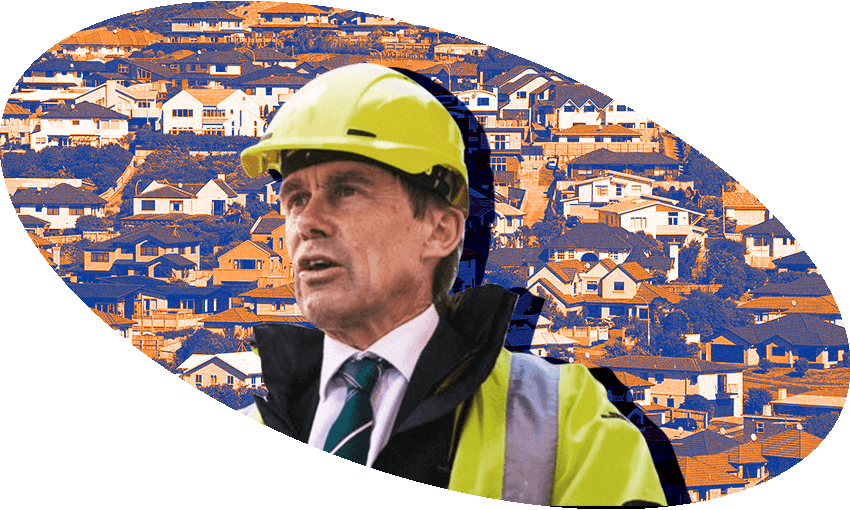A year after a ‘bold’ step was made towards getting more affordable housing built in Wellington, a spanner has appeared in the works in the form of an 11th-hour amendment to the district plan by mayor Andy Foster.
In a six-and-a-half hour meeting last week, Wellington City Council approved its district plan, an enormous 1,281 page-document that sets rules for where dense housing can be built, guiding decision making on a wide range of long-term planning and environmental issues.
This comes almost exactly a year after the council agreed on its spatial plan, which reduced the number of protected “character” areas, allowing new houses to be more easily built in some parts of the central city. This was celebrated as a “bold”, “visionary” step in providing more housing for Wellington.
However, it also maintained height restrictions on buildings, limiting the number of tall buildings, and therefore the construction of dense housing – a move introduced because of concerns that “unlimited building heights could lead to irresponsible building developments”.
The 2021 spatial plan estimated 24,600 to 32,200 homes would be built by 2050, in a city where students and professionals alike regularly form long queues just to view properties. Although this was criticised as possibly being inadequate to fill the capital’s housing shortage, housing advocates largely saw it as a step in the right direction.
But for anyone who’s a fan of building more affordable housing in the capital, it only got worse this year.
The recent district plan, finalised by the Council’s Planning and Environment Committee, was intended to build on the work started by the spatial plan.
Instead, “a very slim majority of councillors, a couple, changed their votes and undid a year’s worth of work, and probably millions of dollars’ worth” of planning, according to pro-density councillor Rebecca Matthews.
In particular, an 11th-hour amendment by mayor Andy Foster – who is yet to announce whether he is running for re-election this year – made two major last-minute changes that will likely lead to less high-density housing being built.
First, the walking catchment – the area around the city centre in which six-storey buildings are allowed to be built – was reduced from 15 minutes’ walking distance, the standard in most New Zealand cities, to 10 minutes. As a result, the city centre will see fewer tall apartment buildings and housing blocks built.
Councillor Teri O’Neill was strongly opposed to this change. “What we want is housing, and we thought we had an assurance of that through the spatial plan.”
Second, the amendment will directly reduce the density of housing in Wellington’s northern suburbs. Foster proposed that the Johnsonville train line no longer be considered a “rapid transit line”, allowing buildings near the train line to be built at a height of fewer than six storeys. This is despite the areas near Johnsonville being among those that will experience the most growth, with many of the 74,500 new Wellingtonians in 2050 expected to live near the train line, according to the council’s own estimates.
Councillor Fleur Fitzsimmons was angered by the mayor’s proposals, arguing that “there will be less land available for density as a result of these decisions”.
Despite passionate opposition from pro-housing councillors, the two changes both passed narrowly, by eight votes to seven.
After a short break, councillors were told that the mayor’s reduction of density near the Johnsonville line was directly contrary to the national policy statement on urban development; in other words, that it was illegal. Although the anti-density amendment was reworded slightly, it may still be in breach of the law.
“What the mayor proposed was definitely illegal, but what we ended up with is possibly illegal,” explained Matthews, who voted against the amendments. “It’s anti-housing, but also just poor decision making.”
One councillor who did support the mayor’s proposal was Planning and Environment Committee chair Iona Pannett. She had previously been supported by the Green Party but was voted out at a selection meeting in April over her support for heritage and character areas.
“The problem is that it’s been heritage versus housing, when actually you can have both,” argued Pannett, who will campaign for re-election as an independent in October.
Live Wellington convenor Jane O’Loughlin was disappointed that heritage and character areas weren’t expanded even further. “This [density] is much more than is required for the population increases we are expecting,” she said. “What this will result in is the inner-city suburbs losing their identity and becoming a hodgepodge of styles and sizes, with six-storey buildings sprouting up here and there.”
The district plan will now be sent to independent commissioners for analysis, while the public are able to make submissions on it next year.
With current prices and interest rates making it the worst time in 65 years to be a first-home buyer, and Wellington rents the highest in the country, things look bleak for anyone who doesn’t have a place of their own. The capital city’s local elections will certainly be worth a watch.





